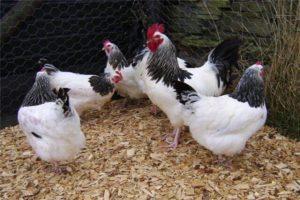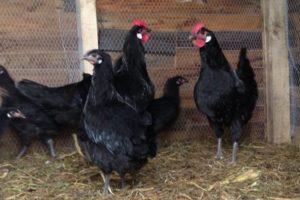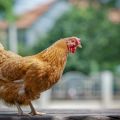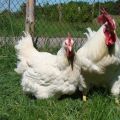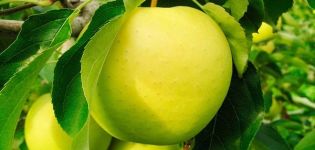Description and characteristics of Rhode Island chickens, breeding features
This variety of chickens began to be bred 200 years ago in Massachusetts by crossing several species. The main producer was the red Malay rooster, from which the new breed acquired a dense plumage and reddish color. At the beginning of the last century, Rhode Island chickens began to be imported to the European continent and quickly spread across it, and in 1926 they reached Russia.
Description and characteristics of Rhode Island chickens
Due to their high vitality, resistance to infections, and rapid growth, individuals of this breed are the best suited for keeping on private peasant farms. Rhode Island chickens are not picky about the content, food, and in addition, they are peaceful, which allows them to be kept next to other animals.
Appearance
Chickens of this breed are distinguished by dark, reddish-brown plumage, with a bright reddish shaft of feathers. There are chickens with a lighter color.
The head is small, with a red or pink standing crest, brown eyes and a yellow-brown beak. The body is elongated, with a broad back. The neck is small and fluffy.
In hens, the tail is almost horizontal to the body, in roosters - at an angle, short and lush. The plumage on the tail is blackish with a greenish tint.
Representatives of Rhode Island are characterized by a convex chest, small, tightly pressed wings, and strong yellow legs.
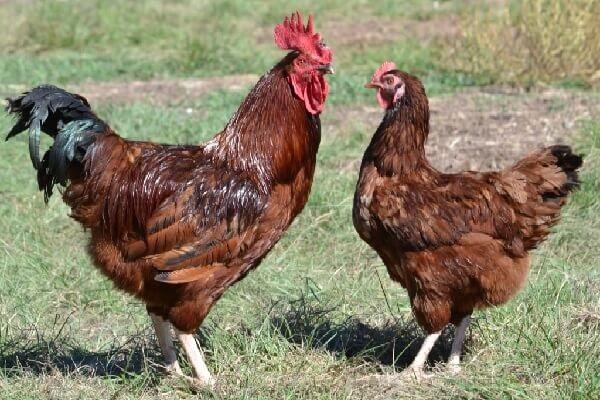
Chicken productivity
Chickens of this breed are meat and egg-laying at the same time.
Due to these qualities, Rhode Island birds are used by breeders to breed other breeds. The productivity indicator depends on the quality of the feed and the conditions of keeping.
Indicators of meat (weight of chickens and roosters)
The weight of a one-two-year-old Rhode Island rooster ranges from 2.4 to 3.4 kg, there are individuals weighing up to 4 kg. Chickens weigh 2-3 kg. Chicken meat is tasty and tender, pleasant appearance.
Egg production indicators (egg weight)
Chickens begin to lay at the age of 6-7 months and are capable of laying up to 170-180, and sometimes about two hundred eggs per year.
In the cold season, egg production practically does not decrease.

Eggs have a brown shell and weigh 50-65 grams.
The nature of the birds
Rhode Island chickens have a calm disposition, roosters are not aggressive, although they are quite mobile. Kindred rarely fight among themselves, fuss little in the henhouse. Chickens get used to the owner quickly, and let him go to the eggs.
Breed varieties
There are two more subspecies of this breed, bred at different times.They differ from each other in appearance, although they have similar characteristics of body structure and productivity.

One of the varieties is chickens with white plumage. This breed was bred much later, and in fact is somewhat different, although it is taken for crossing with brown individuals to obtain more productive hybrids.
The Germans bred dwarf Rhode Island chickens in both colors. They are distinguished by lighter plumage and egg color. Mini-chickens weigh half as much as their large relatives and lay eggs weighing 40-45 grams.
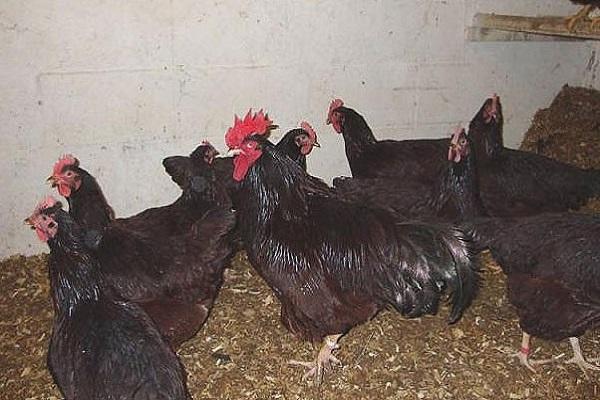
Pros and cons
The positive qualities of Rhode Island include:
- tolerance for conditions of detention;
- versatility (meat and egg-producing at the same time);
- delicious meat;
- high survival rate of chickens;
- early puberty of chickens.
Cons are:
- average egg production;
- unwillingness to sit on eggs.
Rhode Island Chickens are recommended to be grown by private farms, while this breed is not bred for commercial purposes.

The intricacies of keeping Rhode Island chickens
Chickens of this breed are considered not suitable for keeping in cages, although in practice this rule is often violated. Due to their dense plumage, they are not afraid of cold weather and can be outdoors until they drop to minus 10 C, finding their own food on their own.
Chicken coop requirements
The chicken coop should be insulated, equipped with perches (the desired height is about 80 cm from the floor), places for nests, as well as additional lighting in the dark.
It is recommended to lay a litter of sawdust on the floor, which will only be poured in winter and cleaned out completely in summer. Regular cleaning and periodic disinfection of the chicken coop is also important.

The chicks are kept at a temperature of about 30C, weekly reducing it by 2 degrees for early adaptation. At the age of 1.5 months, they are moved to adult birds.
Aviary requirements
Birds feel good on the run, chickens of this breed simply need it. However, they are able to quickly eat all the greens they meet on the way. In order to prevent damage to seedlings growing in the garden, the chicken aviary must be protected with a net.
It is recommended to put bowls with sand and ash in the aviary, where the chickens will swim, protecting themselves from parasites.
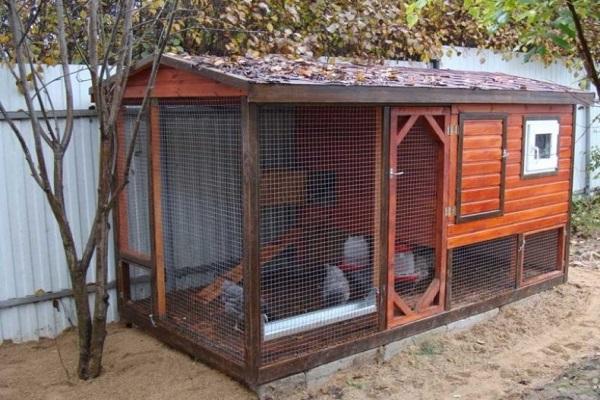
Slaughter age
Until the age of 1.5 years, egg production in Rhode Island chickens grows, and then begins to decline. At the age of 2 years, they can be sent for slaughter.
What to feed?
Representatives of this breed are not picky about food. On the run, Rhode Island chickens are able to independently obtain their own food, adding greens to their diet.
Chicks
It is recommended to feed young males with higher calorie feed than future layers, therefore, slightly grown chickens are usually separated.
The first feed is compound feed for chickens or millet porridge mixed with egg and finely chopped herbs, cottage cheese, boiled fish. Then new products are gradually introduced. Babies eat dandelions and finely chopped nettles well.

Chicks are given only warm water to drink.
Adults
Rhode Island chickens are not picky about feed. Adults are fed with cereals, mash, grain, vegetables or special feed. The diet of birds should have enough barley, rye, wheat, oats, corn. It is recommended to add cake, grated chalk and meal.
Ready-made industrial compound feed usually contains all the necessary components.
In summer, half of the diet should be greens (tops of carrots and radishes, nettles, cabbage leaves), you can give chickens pumpkin or zucchini, as well as sunflower seeds.
Water is poured into drinking bowls to avoid tipping over. Vitamins are periodically added to the diet.
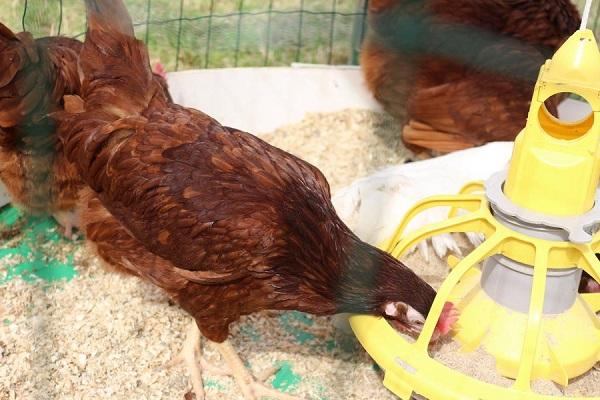
How to breed the breed correctly?
To breed a breed for a group of ten chickens, one rooster is enough.However, not every Rhode Island hen wants to become a brood hen; half of them do not sit on eggs at all. Therefore, to hatch chickens, you need to purchase an incubator, or lay eggs under other chickens.
You need to select eggs by carefully examining the shell - there should be no cracks or other defects on it. The eggs are placed in an incubator with a temperature of 37.6 ° C. Chicks will hatch from the clutch. Chicks have a reddish color; in future hens, a characteristic spot on the head is noticeable already at one day of age.
The survival rate of chickens reaches 70-95%. Chicks grow quickly, but they do not overgrow feathers immediately, therefore, at an early age, they are sensitive to cold weather. They become sexually mature by 7 months.
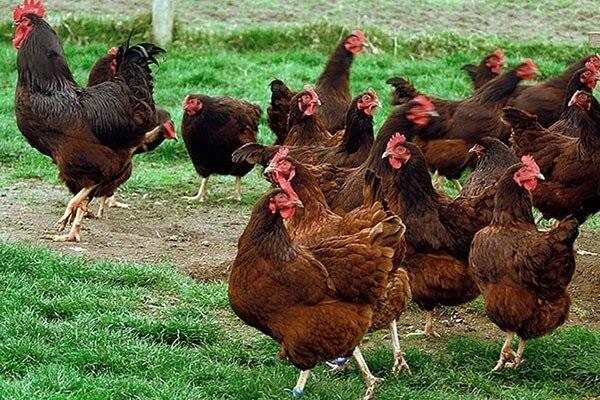
Frequent illnesses
From an early age, chickens are vaccinated against infectious diseases. However, this does not give a 100% guarantee against the disease, although it seriously reduces the risk of infection. Birds can get sick from poor quality care or unbalanced nutrition.
The signs of the onset of the disease are considered to be lack of appetite, lethargy, dull eyes and frayed plumage. It is recommended to isolate the diseased individual from the rest.
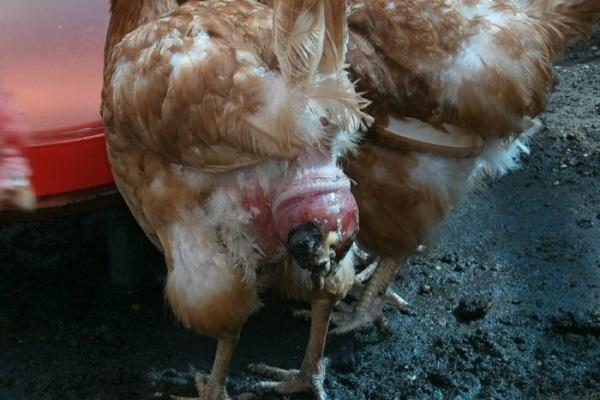
Most often, the following diseases are found in chickens of this breed:
- Cholera. The chicken does not eat anything, it becomes weak, the comb turns blue, and diarrhea occurs.
- Paralysis. Chickens begin to limp, the tail becomes motionless, the eyes - the gray area of the neck looks constrained.
- Smallpox. As a rule, the bird becomes infected in winter, infection can penetrate through cuts. Symptoms of the disease are white spots on the skin, tongue, and oral mucosa. The chicken becomes lethargic, loses its appetite. If one individual is sick, it is urgently removed from the poultry house and the rest of the chickens are disinfected.
- Lice. Chickens lose their plumage, worry, stop eating.
- Ticks. The legs become covered with scales, swell, and growths appear on them. The beak and skin turn red, peel off, itching appears.
- Inflammation of the cloaca (cloacitis). Laying hens are more often sick. The reason is the wrong diet. Signs of cloacite are secretions that contaminate the feathers near the anus.
- Bowel diseases. Chickens suffer from constipation, become depressed. Sick individuals need a diet using sunflower oil.
- Coccidiosis (eimeriosis). An infectious disease transmitted from a newly introduced livestock. It occurs only once, but the recovered individual remains the carrier. The first symptom is diarrhea with clots of mucus or blood, and dull feathers and scallops.
Pullorosis. It can occur in one of two forms - acute and permanent. It is an infectious disease. Symptoms: emaciation, heavy breathing, blanching of the scallops.
